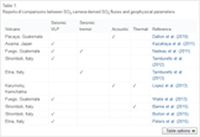Volcanological applications of SO2 cameras
Burton M.R., F. Prata, U. Platt (15 July 2015).
Journal of Volcanology and Geothermal Research, Volume 300, Pages 2-6, doi:10.1016/j.jvolgeores.2014.09.008
Abstract
Ground-based volcanic gas and ash imaging has the potential to revolutionise the way in which volcanoes are monitored and studied. The ability to track and quantify volcanic emissions in space and time with unprecedented fidelity opens the door to integration with geophysical measurements, allowing breakthroughs in our understanding of the physical processes driving volcanic activity. In May 2013 a European Science Foundation funded Plume Imaging workshop was conducted in Stromboli, Italy, with the objective of bringing the ground-based volcanic plume imaging community together in order to examine the state of the art, and move towards a ‘best-practice’ for volcanic ash and gas imaging techniques. A particular focus was the development of SO2 imaging systems, or SO2 cameras, with six teams deploying and testing various designs of ultraviolet and infrared-based imaging systems capable of imagining SO2. One conclusion of the workshop was that the term ‘SO2 camera’ should be applied to any SO2 imaging system, regardless of wavelength of radiation used.
This Special Issue on Volcanic Plume Imaging is the direct result of the Stromboli workshop, and together the papers presented here represent the state of the art of ground-based volcano plume imaging science and technology. In this work, we examine in detail the volcanological applications of the SO2 camera, reviewing previous works and placing the new research contained in this Special Issue in context. The development of the SO2 camera, and future developments extending imaging to other volcanic gases, is one of the most exciting and novel research frontiers in volcanology today.
http://www.sciencedirect.com/science/article/pii/S0377027314002935#


